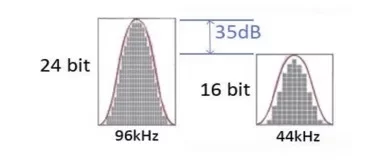With the plethora of new high res streaming services such as Qobuz, Tidal, and Roon, I frequently have audiophiles approach me to discuss how much they love 24-bit recording playback capabilities and the improvements they are hearing. Which begs the question: Are you really 24-bit capable in your system?
Dynamic Contrast

When Sony and Philips introduced the Compact Disc in 1982 consumers were greeted with a 16-bit audio format that achieved a 90 dB S/N ratio (96.33 dB theoretical). Today’s recordings are mastered at a bit depth of 24 bits while quality DACs achieve a 125 dB S/N ratio (144.49 dB theoretical).
Nearly four decades have passed since the CD’s debut and consumers can now stream high resolution recordings with 35 dB greater dynamic capability.
So, you have this extra 35dB…where does that go? At the same playback level, that’s 17.5dB more upward dynamics with a noise floor 17.5dB lower. This demands a more powerful, yet quieter amplifier to take full advantage.
Does more amplifier power translate to louder listening levels?
You will enjoy a lower noise floor in your recordings and stronger crests. While that might not make your speakers play louder, the real difference is not in averaged RMS level – it is heard in increased resolution.
What exactly is audio resolution?
My former colleague Dr. Bela Julesz, while teaching at Rutgers, explained that our perception/cerebral processing of audio and video share many similarities. Let’s recall analog VHS tape rendering a mere 260 lines on a 480 scan-line analog monitor. Now recall the increased definition afforded by 720p video and the excitement that followed with the first look at a crisper 1080p image at 2.1 megapixels. Today we can stream 4K at 8.3 megapixels into our homes and the images have taken on a new dimension in depth. This is largely due to our ability to resolve subtle shadowing in all this information. This is not a matter of just brightness or gain, but dynamic contrast.
Today’s higher resolution recordings benefit from amplifiers offering increased voltage capability and significantly lower noise floor. Speakers with large motors can generate high back-EMF on these recordings and will benefit from amplifiers with high damping characteristics. Additionally, many full range speakers now employ two or more woofers and can demand high current than single woofer configurations of the past.

Power = iV
Power is the product of current (i) and voltage (V). Higher amplifier power assures the proper snap in transients and prevents clipping that can damage high frequency drivers. Higher power means dense musical arrangements will avoid the smearing, strain and the inevitable distortion as complex passages reach higher levels.
What increase in amplifier voltage is required to maximize performance potential of 24-bit over 16-bit?
Let’s first recall that the 35 dB realizable increase in total dynamic range difference benefits the noise floor greatly in 24-bit recordings. For calculation purposes, let’s assume that fully half of the 24-bit overall level advantage is allocated to reduction of lower noise floor. Therefore only 17.5dB of this increase of 35Db in dynamic range is allocated to potential upward dynamics.
17.5 dB=20logV24/V16 Solving this equation V24=7.5V16
If a 16-bit recording is maximized on a four ohm pair of speakers driven by 80 watts, you would need 750 watts to realize the potential increase in dynamic articulation afforded by 24-bit while enjoying a music lower noise floor.
The Legacy Advantage
If you thought loud car crashes, rocket launches and dinosaur footsteps are all high power is good for, you might consider the benefits of lower noise floor and increased dynamic resolution.
Legacy’s iV amplifier series delivers.
-Chief Designer, Bill Dudleston
Legacy’s iV Series amplifiers are the most powerful home theater amplifiers to date. Featuring state of the art ICEedge® technology, the powerhouse delivers up to 1kW into 4 ohms at less than 0.005% distortion to each of its channels. The elegant amplifier operates at nearly 80% efficiency at rated output and delivers more than 600 watts into 8 ohms all channels driven while remaining stable into low impedances.